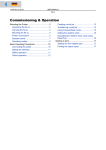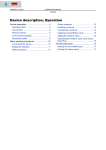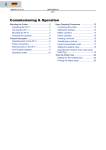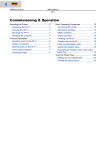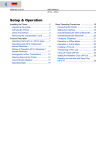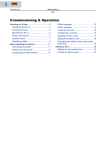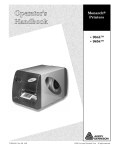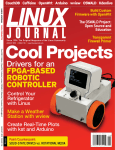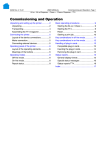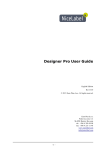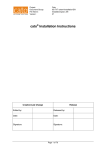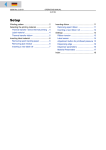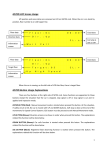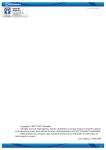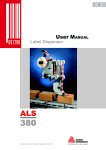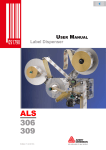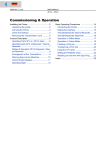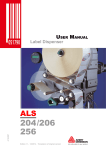Download Commissioning & Operation
Transcript
12/08 Rev. 5.01-01 USER MANUAL 64-xx Commissioning & Operation Mounting the Printer ...................................... 2 Unpacking the 64-xx ................................. 2 Carrying the 64-xx ..................................... 3 Mounting the 64-xx .................................... 4 Printer connections ................................... 5 Operator panel .......................................... 7 Operating modes ....................................... 9 Basic Operating Procedures ....................... 10 Connecting the printer ............................. 10 Setting the interface ................................ 11 Offline operation ...................................... 11 Online operation ...................................... 12 Creating a print job ..................................13 Transferring a print job .............................13 Using CompactFlash cards ......................15 Setting the realtime clock .........................16 Outputting the realtime clock value using Easy Plug .................................................16 Starting to print ............................................17 Settings for the material type ...................17 Printing the status report ..........................17 2 12/08 Rev. 5.01-01 USER MANUAL Commissioning & Operation 64-xx Mounting the Printer Unpacking the 64-xx A 1. Lift off the lid of the shipping box [1]. 2. Take out the plastic bag containing the accessories [1B]. 3. Lift off the styrofoam support [1A]. 4. Part the plastic cover [2]. B WARNING! Printers with mounted cutter: The cutter may cause cut injuries. « Do not grasp the cutter [4A] as a handle. « Use the cutter motor [4B] as a handle. [1] Shipping box without lid: A Styrofoam support B Accessories [2] Open the plastic bag... A B [4] D o n ´t use the cutter as a handle! 5. Grab the printer from underneath and lift it out. The material feed slot in the back wall of the printer [3A] can be used as a handle. A B ¯ Printers with mounted cutter: The motor [4B], but not the cutter [4A] may be used as a handle! C CAUTION! - Do not lift the printer by the front cover [4B]. The front cover is a movable part not designed for handling stress. 6. Place the printer on a level surface in its usual operating position (rubber feet [4C] at the bottom). ¯ The original packaging should always be used for transporting the printer! [3] Lift the printer out of the box. A Back wall of printer (not visible) B Front cover (do not use for lifting) C Rubber feet 3 12/08 Rev. 5.01-01 USER MANUAL Commissioning & Operation 64-xx Carrying the 64-xx WARNING! The 64-xx is a heavy printer. The weight depends on the printer type and equipement and can vary from 20 kg (64-04/05) up to 29.5 kg (64-08 Dispenser). A bad carrying technique can cause back injury. « Try to lift the printer in a safe way, for example by – carrying it close to your body, and by – bending your knees, not your back. « To carry the printer, put one hand under the base plate and the other into the feed slot at the back of the printer. CAUTION! - Do not lift the printer by the front cover (window side), as this can damage it! A [5] B Carrying the 64-xx safely (A: back – grab by the feed slot, B: front – grab by the base plate). 4 12/08 Rev. 5.01-01 USER MANUAL Commissioning & Operation 64-xx Mounting the 64-xx The 64-xx has been designed as a desktop printer, which means that it is normally mounted in an upright position on a table [2]. Other sufficiently large, level and sturdy surfaces can also be used as a base. WARNING! When choosing a base for the printer, observe the following guidelines to avoid dangerous operating conditions: « The base needs to be at least as deep and wide as the printer itself. « The surface needs to be level, solid and dry. « The printer’s fan and ventilation slits must not be obstructed, as the device may overheat otherwise. « The printer must not be mounted in the immediate vicinity of other heat sources. « The environmental conditions specified (temperature, air humidity, etc.) need to be complied with. « The power cable should be run to the printer so that – nobody will trip on it, and that – the power plug can easily be pulled out if necessary. [6] The correct orientation of the 64-04. 5 12/08 Rev. 5.01-01 USER MANUAL Commissioning & Operation 64-xx Printer connections CAUTION! Add-on devices of an inferior quality may damage the printer! « Connect the printer only to devices that fulfil SELV (safety extra-low voltage) circuit requirements acc. to EN 60950! « Only connect OEM devices. I H A J B C L M K D E F G [7] Back of the 64-xx with the following options installed: USI board (H), connector for remote operator panel (I) and start/stop signal input (J). A Card slot For SD/MMC cards; is not yet supported B Card slot For CompactFlash cards; used for storing fonts, logos, graphics, etc. C USB interface type B (device) For transfer of print data D 2x USB interface type A (host) To connect devices (e.g. keyboard, scanner) E RS232 interface For serial transfer of print data F Status-LED/Ethernet G Ethernet interface To connect to an „Ethernet 10/100 Base T“ network 6 12/08 Rev. 5.01-01 USER MANUAL Commissioning & Operation 64-xx H Optional: Signal interface USI y 4 inputs / 8 outputs y Standard at „64-xx Dispenser A“ I Optional: Mini-DIN connector To connect a remote operator panel J Optional: start/stop signal input y Standard at 64-xx Dispenser y To connect a foot switch (signal starts printer) or a stacker (signal stops printer) K Centronics interface For parallel transfer of print data (cable is inclusive) L Power switch Turns the printer on/off M Mains power supply connector Connection to a mains socket using the provided power cable 7 12/08 Rev. 5.01-01 USER MANUAL Commissioning & Operation 64-xx Operator panel Display Prog button Feed button Online button Cut button [8] Operator panel of the 64-xx. Display With 32 digits and two lines, the display shows the operating conditions (modes) for parameters, values, status and errors. You can select the language you want to use for the display. Backlighting ensures good legibility. Button functions The buttons offer a multitude of operating functions. A logical menu structure is used for operation. The meaning of each button varies according to the operating mode and the menu item. Additionally, special functions have been programmed for certain button combinations. Depending on the modes and menu levels, the following functions apply for each button: Online button y For switching between online and offline mode. y For confirming entries, menu items and messages. y For selecting print jobs and for entering values in standalone mode. Cut button y Triggers a cut. Requirements: – Cutter fitted and activated. – Printer offline. y Also for accessing deeper levels within the menu structure and selecting menu items. y For decrementing values. Feed button y For feeding in material when the device is offline. y For starting the printing process once the feed has been stopped (in online mode). y Also for accessing deeper levels within the menu structure and selecting menu items. y Increments values. Prog button y For accessing the parameter menu when offline. y For stepping back through the parameter menu and/or exiting it. 8 12/08 Rev. 5.01-01 USER MANUAL Commissioning & Operation 64-xx y For more detailed descriptions of the button functions, please see – Chapter Offline operation on page 12 and Chapter Online operation on page 13 – In topic section Info-Printouts and Parameter Remote operator panel 64-0x Gen. 3 (or higher) machines can be equipped with a remote operator panel. For this, the printer must provide the appropriate - optional - connector, see chapter Printer connections on page 5. The connection can be retrofitted (see service manual). The button functions are the same as those on the standard operator panel. Exception: The on/off switch is not available at the remote control panel. With the remote control panel connected, both panels are active and show the same information. CAUTION! Manipulating both operator panels simultaneously can cause malfunctions. « Always use only one operator panel at a time to operate the printer. (Using both operator panels alternately is admissible). CAUTION! If the connection cable is longer than 2.5 m, EMC-caused disturbances can occur. « Only use the factory-installed cable. « Don´t extend the cable. [9] Remote operator panel (article number A8293) 9 12/08 Rev. 5.01-01 USER MANUAL Commissioning & Operation 64-xx Operating modes Offline mode Printer settings can be made when the device is offline. The offline mode is normally active when the printer is switched on. Print jobs are received via the selected interface but not processed. OFFLINE 0 JOBS No jobs are waiting to be processed. To configure the printer so that it goes directly into online mode when switched on, set the parameter SYSTEM PARAMETER > Active Mode to “Online”. Online mode In online mode, print jobs are received and processed immediately. Possible messages: ONLINE 0 JOBS No jobs are waiting to be processed. ONLINE 0: JOBS The current data transfer to the printer is shown on the display. This is indicated by the dot on the bottom right next to the number of loaded jobs. Another point on half line height above the first shows the interpreter status: y No point: No data to interpete. y Solid point: The interpreter is busy (still data left in the spooler). y Flashing point: The interpreter is waiting for data required to complete a command (no data in the spooler). ONLINE 13 JOBS During printing, the display also shows the number Restcount: 25 of print jobs read (13) and the remaining number of labels (25) to be printed in the current job. ONLINE 13 JOBS If a print job recognises an endless number of labels Restcount: endless to be printed, then the remaining number for this job is also shown as endless. ¯ To stop printing, press the online button. Message mode The printer uses status reports to signal an error or a particular operating status. This message mode indicates that the printer is waiting to quit or for fault clearance. When quitting, the printer switches from message mode to offline mode (depending on the error and the progress of the last active process). Status 5001 Messages are made up of the status number and a No gap found brief descriptive text. The status message 5001 (shown above) occurs when for example the printer is set for punched label material, but continuous form material without punches has been inserted. In this case, the printer will continue to feed the material for a few seconds before it generates an error message. Status Reports: see topic section „Status Reports“. 10 12/08 Rev. 5.01-01 USER MANUAL Commissioning & Operation 64-xx Standalone mode In standalone mode, print jobs are not transferred but saved on a plugin card. They are started directly from the printer’s operator panel or via a connected keyboard. Standalone mode: see topic section „Advanced Applications“. 11 12/08 Rev. 5.01-01 USER MANUAL Commissioning & Operation 64-xx Basic Operating Procedures Connecting the printer WARNING! The printer operates using mains voltage! Touching electrically live parts can cause exposure to hazardous electrical currents and may lead to burns. « Make sure that the printer is switched off before connecting the power cable. « Only operate the printer using the system voltage indicated on the nameplate. « Only connect the printer to a grounded power socket fitted to authorised standards. « The power cable should be run to the printer so that – nobody will trip on it, and that – the power plug can easily be pulled out if necessary. 1. Ensure that the printer power switch is set to “0” (off). 2. Connect the printer to the power supply using the cable [9B] provided. 3. Using the data cable supplied, connect the Centronics interface [9A] on the printer to the host computer. A B [10] Sockets for the Centronics cable (A) and power cable (B) on a 64-04 4. Turn on the printer using the power switch (set to position “1”). The following sequence of messages is displayed: System start... The boot loader is starting. System start... Start user prog Valid firmware recognised, program is starting. 64-05 V 4.10 Printer type Version number of the printer firmware 12 12/08 Rev. 5.01-01 USER MANUAL Commissioning & Operation 64-xx Memory: 64 MB Flashcard: 32 MB Internal RAM (here: 64 MB) Optional RAM on the CompactFlash card (here: 32 MB) – only displayed when a CompactFlash card is in use. OFFLINE 0 JOBS Initialisation Offline mode ONLINE JOBS Online mode. The unit is ready for printing. 0 ¯ When the parameter SYSTEM PARAMETER > Active Mode is set to “Offline”, the printer switches directly to offline mode when turned on. ¯ CAUTION! - Wait at least 10 seconds between switching the device off and on again, otherwise any modified parameter settings are not saved. Setting the interface By factory default, the 64-xx is set for data transfer via the Centronics interface. Print data can also be transferred via the RS232, USB or Ethernet interface. « The interface type is selected with the following parameter: INTERF. PARAM. > EASYPLUGINTERPR > Interface Setting parameters: see topic section „Info-Printouts and Parameters“, chapter “Using the Parameter Menu”. Data cables: Ordering nubers can be found in topic section „Accessories“. Ethernet interface: Information about using it can be found in topic section „Advanced Applications“. 13 12/08 Rev. 5.01-01 USER MANUAL Commissioning & Operation 64-xx Offline operation y Switching from offline mode to online mode: Online OFFLINE x JOBS ONLINE x JOBS y Switch to online mode when the print job is stopped: Online OFFLINE x JOBS ONLINE Stopped xx Stopped x JOBS xx y Slow material and ribbon feed: OFFLINE x JOBS Online Feed y Material travels backwards under the printhead: OFFLINE x JOBS Cut Online y Reset: OFFLINE x JOBS Cut Online Feed OFFLINE feeding… x JOBS OFFLINE feeding… x JOBS OFFLINE x JOBS y Access the parameter menu, see topic section Info-Printouts & Parameters OFFLINE x JOBS PRINT INFO Prog y Feed material until the next punch is reached or as long as the button is held down: OFFLINE x JOBS OFFLINE x JOBS Feed feeding… y Standalone operation: Selecting a print job stored on a CF card (e.g., Testdat.FOR), see topic section Advanced Applications , chapter „Standalone Operation“: OFFLINE x JOBS Choose a file Online Prog Testdat.FOR 14 12/08 Rev. 5.01-01 USER MANUAL Commissioning & Operation 64-xx Online operation y Switching to offline mode: ONLINE x JOBS OFFLINE Online x JOBS y Setting the print contrast: Press the Feed button to increase and the Cut button to decrease the print contrast. ONLINE x JOBS Print contrast Prog xxx% y Interrupting the print job: The device will finish printing the current label. ONLINE X JOBS ONLINE X JOBS Online Restcount XXX Stopped XXX a a) The message “Stopped xxx” alternates with “Press Feed”. y Switching to offline mode while the print job is stopped: ONLINE X JOBS OFFLINE Online Stopped XXX y Continuing the print job: ONLINE X JOBS Stopped XXX Feed x JOBS ONLINE X JOBS Restcount XXX y Standalone operation: Selecting a print job stored on a CF card (e.g., Testdat.FOR), see topic section Advanced Applications , chapter „Standalone Operation“: ONLINE x JOBS Choose a file Online Prog Testdat.FOR 15 12/08 Rev. 5.01-01 USER MANUAL Commissioning & Operation 64-xx Creating a print job Essentially, there are two ways of creating a print job: Either by using the 64-xx Windows printer driver, or by creating a text file using print commands. Windows printer driver 64-xx printer drivers are available for different versions of Windows. You can print from nearly every Windows application using the printer drivers. However, functionality is strongly dependent on the choice of software. Special label layout programs are best suited, for example NiceLabel (a demo version is included with the printer shipment). ¯ The driver’s help function explains how to use the printer driver. The help function of your Windows operating system will tell you how to install the driver. Printer drivers for the different versions of Windows can be found on the Internet at (http://www.machines.averydennison.com/printersystems_gb.nsf/ wview/L4L3?OpenDocument) Command file You can write a sequence of commands in a text file and send it to the printer. To do this, you can use any text editor and the MS-DOS Copy command. Easy Plug provides a special command language to program print jobs. However, writing a print job in text file format does require some programming knowledge. Furthermore, you will not be able to preview the resulting printout on the screen. Instead, you have to run a test print to see a copy of the finished result. Easy Plug Manual: here you can find a practice example of a print job together with instructions in the section “Program Example” in topic section “General, Definitions Commands Overview”. Transferring a print job The printer can only carry out a print job once this job has been transferred into the printer’s RAM. This can be accomplished in two ways: via a direct transfer from your computer via a data cable or by saving it to a CompactFlash (CF) card. Data cable The print job can be transferred y via the serial interface, y via the parallel interface, or y via the Ethernet connection. To transfer data via the serial or parallel interface, connect the corresponding ports on the host computer and the printer. Use the DOS window to send the print job file to the interface: y Serial interface (COM1): copy testjob.txt com1 y Parallel interface (LPT1): copy testjob.txt lpt1 y USB interface / Ethernet interface: copy testjob.txt \\computername\sharename. – computername = Name of the computer (e.g., “DM-ECH-0990”). In Windows XP this can be found under START > SETTINGS > CONTROL PANEL > SYSTEM > COMPUTER NAME. – sharename = enter the name found under START > SETTINGS > PRINTERS AND FAXES after clicking on a printer symbol and right- 16 12/08 Rev. 5.01-01 USER MANUAL Commissioning & Operation 64-xx clicking PROPERTIES > SHARE (in Windows XP). The sharename stands for a printer, which is connected to a certain port. This is the USB port for tranferring via USB and the TCP/IP port for transferring by Ethernet. A few hints on using the USB interface: ¯ The method described here does not work in Windows 98, Windows ME or Windows NT 4.0. ¯ The sharename has to comply with the MS-DOS formatting conventions (no more than 8 characters, no symbols or spaces). Ethernet interface: Information about using it can be found in topic section „Advanced Applications“. ¯ Before sending a print job from a text program, you need to ensure that the correct printer driver has been installed. ¯ Special label layout programs, such as NiceLabel, make this much easier. These programs also require a driver to be installed. CF card You require the following items to load a print job from a CF card: y CF card (copy the print job to the directory \FORMATS) y CF card reader (to connect to your computer) Transferring print jobs via CF card: A detailed description can be found in topic section „Advanced Applications“, chapter “Standalone Mode”. 17 12/08 Rev. 5.01-01 USER MANUAL Commissioning & Operation 64-xx Using CompactFlash cards CF = CompactFlash CAUTION! - Observe the following guidelines to avoid damaging the printer or the CF card. « Only use CF -cards approved by the manufacturer. « Always wait at least 5seconds after switching off the printer before removing or inserting the CF card. « When inserting or removing the CF card, never use force. ¯ The printer firmware cannot utilise more than 128 MB of card storage capa- city. Slim guide notch Wide guide notch Contacts [11] Example: A 32 MB CF card Suitable CF cards: see Plugin-card manual, topic section „Card types“, chapter „CompactFlash card“. Applying CF cards: see Plugin-card manual, topic section „Application“, chapter „CompactFlash card“. Inserting a CF card 1. Switch off the printer. Wait for 5 seconds. 2. Insert the CF card [11A] completely into the card slot, contact side first. The card’s label is on the right side. ¯ Push the CF card into the slot until the release button [11B] comes out. The inserted card will sit flush with the back wall of the housing. ¯ The differently sized guide notches [10] of the CF card prevent the card from being inserted wrongly. For the card to be inserted correctly, the wider guide notch needs to be on top. Removing a CF card « Press the release button [11B] to remove the CF card. A B [12] Inserting the CF card. If the CF card has been inserted correctly, it will sit flush with the printer’s back wall (right). 18 12/08 Rev. 5.01-01 USER MANUAL Commissioning & Operation 64-xx Setting the realtime clock The realtime clock in the 64-xx printers can be used, for example, to calculate and print the expiry date of a perishable product. This is how you set the realtime clock: 1. Navigate to the SYSTEM PARAMETER > Realtime Clock. Realtime clock dd.mm.yyyy hh:mm dd = day, mm = month, yyyy = year, hh = hour, mm = minute 2. To enter the date and time, use the Cut button to shift the cursor, the Feed button to change the parameter, and the Online button to save it. Setting parameters: see topic section „Info-Printouts and Parameters“, chapter “Using the Parameter Menu”. Outputting the realtime clock value using Easy Plug Use the following Easy Plug commands to output the current realtime clock value: y #YC realtime as text y #YS realtime as barcode y #DM download month names Easy Plug manual 19 12/08 Rev. 5.01-01 USER MANUAL Commissioning & Operation 64-xx Starting to print Settings for the material type The parameter settings described below provide the printer with the necessary information about the label material used. When printing from a layout program, these settings are usually provided automatically by the printer driver. For your first test prints, you need to configure them manually. Material type y The label material is “endless”, which means that it contains no punches/ perforations, breaks or reflex marks that could be recognised by the punch sensor: « Set the PRINT PARAMETER > Material Type to “endless”. y The label material contains punches/perforations, breaks or reflex marks that can be recognised by the punch sensor (so-called “punched” material): « Set the PRINT PARAMETER > Material Type to “Punched”. Material length « Set the PRINT PARAMETER > Material Length to the length of the material (in mm). Material width « Set the PRINT PARAMETER > Material Width to the width of the material (in mm). Only for punched/perforated material: Type of punch y Label material with breaks or punches: « Set the SYSTEM PARAMETER > Sensor Type to “Punched”. y Label material with reflex marks: « Set the SYSTEM PARAMETER > Sensor Type to “Reflex”. Setting parameters: see topic section „Info-Printouts and Parameters“, chapter “Using the Parameter Menu”. Printing the status report A status report printout is a perfectly adequate printer test. The width of the status printout can be set to 100 mm or 50 mm. This should match the width of the label material used. The length of the printout is 200 mm. 100 mm width « Navigate to INFO PRINTOUT > Printer Status. The printout that is triggered spans a label length of 2x 200 mm, listing all of the printer’s current parameter settings. 50 mm width « Set the SYSTEM PARAMETER > Print Info Mode to “Compact right”. « Navigate to INFO PRINTOUT > Printer Status. The printout that is triggered contains the same information as the wider printout, compressed to a width of 50 mm. Density If the printout is not as black as you would like it to be, increase the print density as follows: 1. Press the Esc button while in online mode. Display: Print contrast 60% 2. By pressing the Cut/Feed buttons, you can increase or decrease the heat energy of the printhead (in %). 20 12/08 Rev. 5.01-01 USER MANUAL Commissioning & Operation 64-xx The heat energy should be kept as low as possible while retaining an acceptable printing result. A high level of heat energy reduces the lifespan of the printhead.




















